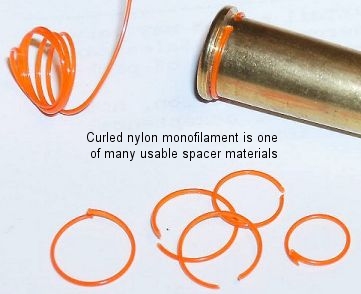-
FREE MEMBER
NO Posting or PM's Allowed

WTK source for #3 bolt head for #4 rifle
Howdy. This my first post here. Used to read the old board in the old format. CSP Gun Talk forum was my first indication on 9/11/01 to turn on the TV.
Gun Talk forum was my first indication on 9/11/01 to turn on the TV.
My impression from the old days was that the Enfield board on CSP was one of the tougher ones. Haven't had a chance to confirm that, yet. Might happen shortly, though, depending on how people read this request for information.
My rifle (No4M2, 11/54 Fazerkerly, no FTR) needs a longer bolt head. Found this out when processing fired HXP 75 brass. Did an experiment today with MEN 83 (W.German , destination, the 'Stan back in the days) and with some '80s vintage South African ball.
, destination, the 'Stan back in the days) and with some '80s vintage South African ball.
Reason for this was because Greek HXP 75 was stretching so much on its first fire. To about 2.226" on average, prior to neck sizing. Something not right... right?
The experiment was to put a regular old target paster on the bolt head, trimmed to fit, and to chamber the MEN and the SA factory rounds. There was no resistance on lockup, with this field expedient. Could that be a clue?
I need to get the best life out of what brass I have, plus will be ordering some new RP,and want the same for it.
I'm thinking that this pretty-unused rifle has long headspace, I would like to experiment with a longer bolt head. What's on it is a #2.
I've looked around today at Springfield Sporters, Sarco, Gun Parts Corp (Numrich), and APEX. Don't see a #3 bolt head for sale. Any ideas as to where to get one?
I'd appreciate any source. Also would welcome comments about how my reasoning for getting a longer bolt head might be wrong.
Information
 |
Warning: This is a relatively older thread
This discussion is older than 360 days. Some information contained in it may no longer be current. |
|
-
03-25-2009 06:41 PM
# ADS
Friends and Sponsors

-
Legacy Member

Bolt Head Sizes - AGAIN !!
Have you actually checked your headspace ?
If so have you used proper military headspace gauges or the incorrect SAMMI gauges. ?
No4 bolt heads are marked up :
0.1.2.3
The sizes SHOULD be slight incremental increases with 0 as the smallest.
Some time ago I investigated rumours that the size (number) was almost irrelevant to the actual bolt head size.
I (and a few friends) measured over 100 bolt heads and found that in fact you could get a number 1 bolt head smaller than a No2 bolt head, or a No2 bolt head larger than a No3 bolt head.
The actual results were :
Size / Number 0 went from 0.620" - 0.631"
Size / Number 1 went from 0.622" - 0.635"
Size / Number 2 went from 0.630" - 0.640"
Size / Number 3 went from 0.632" - 0.640"
Some folks contested the results as they were measured by different people using different instruments - but I stand by the fact that the size / number is indicative only and not a 'measurement'
If you need a new bolt head specify the dimension needed - not the 'next size up' - you could end up worse than when you started.
Size 3 bolt heads are not cheap but you may not need a Size 3. Measure what size you've got, does it close on a 0.074" Military head space gauge (NOT a SAMMI 0.070" gauge)
Yes - I know the pic is a No1 bolt head but the principle is the same !!!
Last edited by Alan de Enfield; 03-25-2009 at 07:03 PM.
Reason: Typo.
-
-
-
Legacy Member

[QUOTE=Prairie Fire;31172]
Reason for this was because Greek HXP 75 was stretching so much on its first fire. To about 2.226" on average, prior to neck sizing. Something not right... right?
QUOTE]
The correct length should be 2.222" so your only 0.004" (4 thou) oversize I wouldnt have thought that was enough to worry about if you are reusing the cartridge in the same rifle.
Rimmed cartridges headspace off the 'rim' not the neck so I personally dont see an issue - maybe a more experienced reloader could comment.
-
-
FREE MEMBER
NO Posting or PM's Allowed

Alan de Enfield: Thanks for your responses. Info I have is that "trim-to" length is 2.212", and max case length is 2.222". I'd like to get all cases to that trim-to length prior to using them again. And I don't want to screw them up by pushing down the shoulder, if the better idea is to fix the gun.
If the rifle is wrong (closing on factory ammo with a paster on the front of the bolt [don't laugh, we do those sort of things to try and solve immediate problems in Wyoming]), then a bolt head change might be worthwhile to try.
I still think that the rifle is wrong and needs a longer bolt head. I'm still looking for a source for a #3 bolt head.
Your comments on how differemt numbered bolt heads vary in size, is appreciated. With that in mind, and no good Enfield gunsmith within six hours of road travel, I prefer to solve my problem by doing gross things and figuring them out on my own (with internet help. )
My bottom line, is that the reloaded cases have to chamber with no more resistance than is encountered with various surplus ball. And at the same time, I'd like to to make my cases last for a bit. My idea to accomplish this, is to make my current chamber smaller via a longer bolt head.
Anybody have a #3 bolt head FS?
-
Advisory Panel


1. Paper is too squishy for accurate headspace measurement. If you don't have access to real gauges, at least use metal shims. Beer cans are about .004" and are easy to cut. Stick shim(s) to an empty, sized (or new) case with a tiny dab of sticky grease. Assuming your cartridge rims are the average of about .060", you could stack up three of these shims (.012") and still have .072" headspace - within specs (maximum .074"). But don't assume - measure the rim to find out exactly how thick it is.
2. Unless you have measured the rims of the cartridges you're using, you have no idea if your putative problem belongs to the rifle or the cartridges. With a No.4 Mk.2, it's very unlikely you have a rifle problem unless the bolt is mismatched.
3. Measuring overall case elongation is not a good way to check headspace. Cases fired with some end play elongate at the head end due to wall thinning and stretching, but they also shorten at the front end when they expand in diameter to fit the chamber.
4. Most .303 case life problems come from aggressive FL sizing and/or stiff loads. Back off the sizer so cases chamber with zero end play and back down the powder charge a few grains below "maximum" and cases will last for dozens of firings in any decent Lee Enfield.

.303 case with rim removed, fired 20 times with a load giving about 40,000 psi (180 grain bullet at 2310 fps), sectioned to demonstrate lack of stretching with moderate pressure and sizing that does not create end-play.
If your rifle has generous headspace and/or your cases have thin rims, employ an improvised spacer ahead of the rim on the first shot to eliminate initial stretch.

You can find more opinions on this subject at Headspace 101 for .303's
-
-
FREE MEMBER
NO Posting or PM's Allowed

Parashooter, approx. what is the diameter of the monofilament line you use for a spacer to prevent excessive stretching? Might give that a try. Thanks for the tip!!
-
Advisory Panel



Originally Posted by
me2

Parashooter, approx. what is the diameter of the monofilament line you use for a spacer to prevent excessive stretching?
30 pound test - never measured diameter. Anyway, choose a size that works for your rifle and cases, not mine.
Improvise, adapt, overcome!
-
-
Banned

As Mr. Parashooter stated, adapt, improvise, overcome!
Rubber o-rings come in many sizes, and they work.


-
(Deceased April 21, 2018)

Of course it's not the bolt head that wears, but the reciever. Sometimes changing the bolt will bring things back to normal. But then who has a selection of bolts?
-
Banned


Originally Posted by
John Sukey

Of course it's not the bolt head that wears, but the reciever. Sometimes changing the bolt will bring things back to normal. But then who has a selection of bolts?
Mr.Sukey
Actually three things wear, the receiver, the bolt body and the bolt head.
If this was untrue replacing the bolt and the bolt heads would not have any affect on decreasing headspace.
It appears to me the most wear occurs between the bolt body and the bolt head or simply put 2/3 of the wear is at the bolt and bolt head and 1/3 at the locking lugs and receiver.
Gun Talk forum was my first indication on 9/11/01 to turn on the TV.
, destination, the 'Stan back in the days) and with some '80s vintage South African ball.















 Register To Reply
Register To Reply













